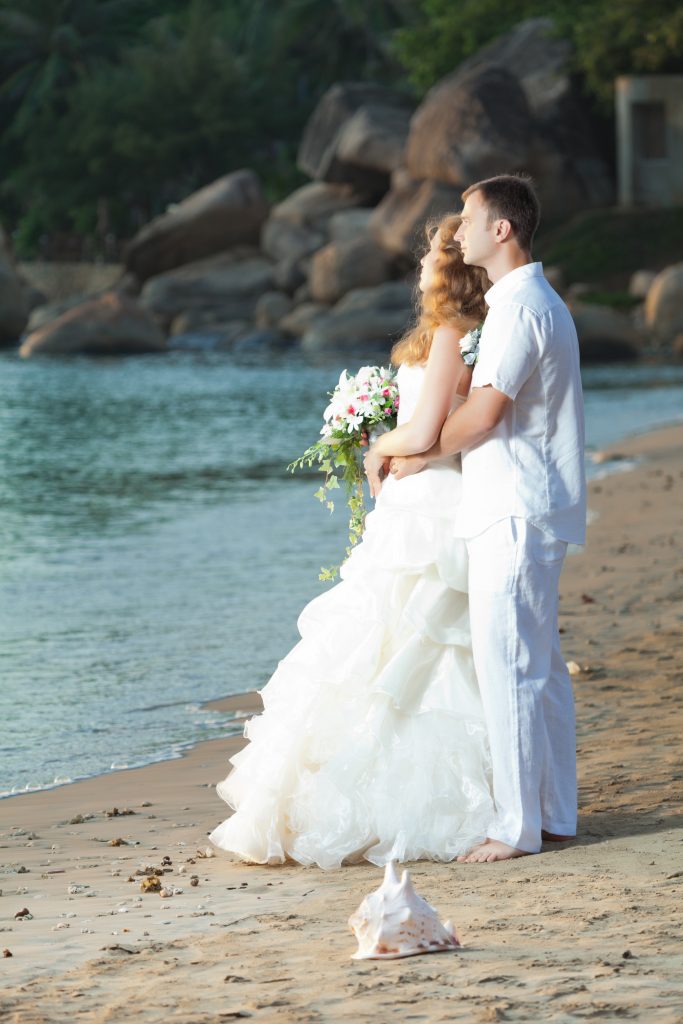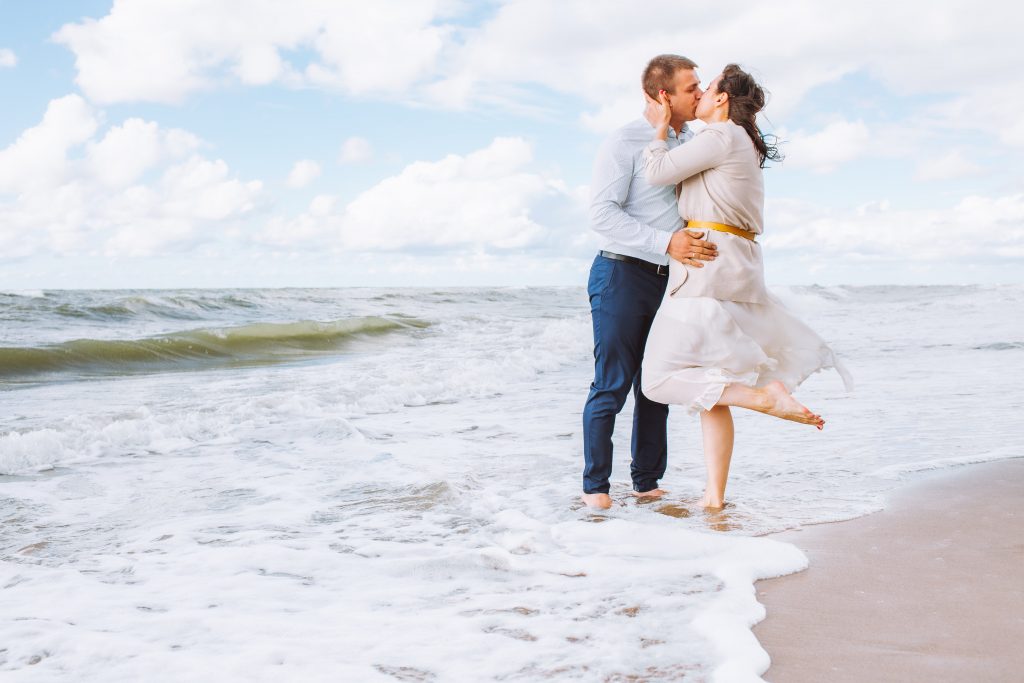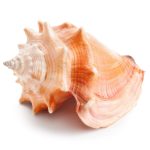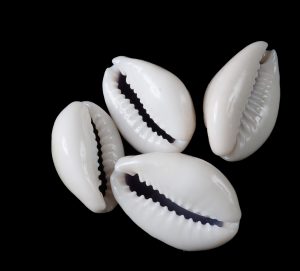
Mother Nature always leaves messages for us. Unfortunately, we don’t always know how to read them.
What messages can you find in seashells? The answers are fascinating.
The answers are important if you’re having a beach wedding!
Couples find walking along the beach romantic. We’ve all seen the photos. The couple holds hands as they stroll barefoot in the sand. Sometimes, they laugh with abandon. Sometimes the gaze intently into each other’s eyes.
Advertisers tap into that emotional atmosphere. They add a colorful sunset or a full moon. All too often the scene winds up looking melodramatic or cheesy.
Comedians jump on the bandwagon. They poke fun at personal ads that claim to want a relationship with someone who also likes to walk along the beach — in other words, a cheap date.
Forget the advertisers and the comedians. I like walking along the beach. I do think it’s romantic. And I’m sure I’m not the only one.
I think there’s a deep-seeded reason people, partnered or single, feel good when they walk along the shore. Simply put, it’s the fresh start symbolized every time a wave washes over the sand and leaves a clean slate.

If you’ve ever played with an old Etch-A-Sketch toy, you know the feeling when you lift the foggy film and whatever you’ve written on the clipboard disappears. At the beach, that clean slate may suggest renewed effort after failure, forgiveness after pain, freedom after constraint, or love after loneliness. Or, what so many struggle with: self-love. Like the Etch-A-Sketch, the clean slate at the beach gives you a second chance.
Symbols
Symbols speak to us in a way that words can’t, because while symbols represent something universal, as do some dream symbols, they also invite us to add our own interpretation.
For example, when we think of forests, we think of old trees, acorns, pinecones, wildlife, moss and mushrooms and medicines waiting to be discovered. We think of fire and destruction, of giant industries and cozy campfires. When I think of forests, I also think of ancestral roots, fairy dwellings, and stories of transformation.
In the same way, crashing waves, a gentle surf, seaweed, sand and seagulls are all universal symbols of the beach. So are shells.
I asked a friend for her immediate association with shells. She said wampum, a form of currency created by Native Americans who made beads from shells. Another friend said portable shelter. My son-in-love said the driveway at the Rhode Island home where he grew up. His father was a commercial fisherman. The white driveway was made of crushed shells. My immediate association is of Aphrodite, the goddess of love and beauty, depicted at the moment of her ocean birth, standing on a giant clam shell.
Ocean Oracle
Several years ago, I purchased a deck of oracle cards. It’s called “Ocean Oracle: What Seashells Reveal about Our True Nature.” The author is Michelle Hanson.
As with the dozen or so other oracle decks I have, this one came with a book that gives information for each card. It also came with two, double-sided, full color fold-outs grouping 200 shells and a few other ocean inhabitants in one of four categories: their behavior, their interaction with humans, their name and appearance, and finally, by the author’s intuition. Each shell on the fold-out is numbered.
I use an oracle or tarot deck every day as part of my morning ritual. I quiet my mind, take a few grounding breaths, then draw a card to help me work with the energy of the day. You can do that with the Ocean Oracle, too. Or, use the fold-outs, pick ten or twelve shells that you’re drawn to. Write down their numbers. Then look up their corresponding cards, meanings and messages. They might not all resonate to what’s happening in your life, but surely some will.
Pink Conch
 When I first looked at the shells grouped by their interaction, I was immediately drawn to the Pink Conch (pronounced “konk”). If you’ve seen the Disney movie Moana you’ve seen conch shells, home to mollusks, sea snails. These medium and large shells have points at both ends — a sharp spire at the top and a softer, moderately flaring funnel-like point at the bottom. The classic body is a rounded whirl with a thick outer fold called a lip. The conch has also been called a “shell horn” or “shell trumpet.”
When I first looked at the shells grouped by their interaction, I was immediately drawn to the Pink Conch (pronounced “konk”). If you’ve seen the Disney movie Moana you’ve seen conch shells, home to mollusks, sea snails. These medium and large shells have points at both ends — a sharp spire at the top and a softer, moderately flaring funnel-like point at the bottom. The classic body is a rounded whirl with a thick outer fold called a lip. The conch has also been called a “shell horn” or “shell trumpet.”
 In some cultures, conchs are used in rituals to call to the spirit world. In the mundane world, the conchs are the shells we hold to our ear believing we can hear the ocean. In reality, the acoustics of the shell simply amplify the blood circulating in our ear. Of course, the pumping of blood is part of our cardio function. As Michelle Hanson puts it, “We are, in effect, listening to our own hearts.”
In some cultures, conchs are used in rituals to call to the spirit world. In the mundane world, the conchs are the shells we hold to our ear believing we can hear the ocean. In reality, the acoustics of the shell simply amplify the blood circulating in our ear. Of course, the pumping of blood is part of our cardio function. As Michelle Hanson puts it, “We are, in effect, listening to our own hearts.”
 Abalone
Abalone
If you’ve ever burned sage, you might have held it in an abalone shell. These are the thick, oval shells with an outer rim of holes the abalone uses to breathe. The shell is lined with an iridescent mother-of-pearl coating called “sea opal.”
In her book Sea Magic: Connecting with the Ocean’s Energy, author Sandra Kynes says the energy of abalone attracts abundance.
Red Abalone
There are about 100 species of abalone. For Red Abalone, Michelle Hanson writes that “extracts from abalone have been used medicinally against penicillin-resistant strains of staph, strep, and typhus.”
She points out what those of us in the metaphysical world know; i.e., that sometimes, if we work on an issue at the energetic level, we can keep that issue from manifesting at the physical level. The late Louise Hay wrote about that concept in You Can Heal Your Life, one of many books she wrote on the subject.
Heart Cockle
My mother was part-Irish. I grew up hearing her sing the popular old folk song, “Molly Malone.” The song was written in the 1800s. It tells the tale of a beautiful young woman, a fishmonger, who wheels her cart through the streets of Dublin selling shellfish. The song begins:
In Dublin’s fair city
Where the girls are so pretty
I first set my eyes on sweet Molly Malone
As she wheeled her wheel-barrow
Through streets broad and narrow
Crying, “Cockles and mussels, alive, alive, oh!”
You can hear multiple renditions of the whole song with a simple search on YouTube.
Cockles are heavily ribbed shells, round or oval, that when viewed from the side look like a heart. Also called “Sailors’ Valentines,” these shells were given as gifts to convey love without words.
Sandra Kynes notes the presence of heart cockles in prehistoric graves in England. That suggests the cockle shell might also have been a symbol for death and rebirth.
Cowrie
Finally, the Cowrie. In general, cowrie shells have been used as currency for centuries. Most mollusks live inside their shells where they secrete a film that hardens to a smooth surface, keeping the mollusk’s tender body safe. The cowrie, on the other hand, lives on the outside of its shell. That’s why cowrie shells are so smooth.
 In old Europe, people thought the opening of the cowrie resembled the reproductive area of a female pig. So they called cowries porcellana, a word that means “little pig.” Michelle Hanson writes that when Marco Polo returned from his trip to China with glazed pottery the likes of which Europeans had never seen, people thought the glaze resembled the surface of their “little pigs.” And so they called the pottery porcelain.
In old Europe, people thought the opening of the cowrie resembled the reproductive area of a female pig. So they called cowries porcellana, a word that means “little pig.” Michelle Hanson writes that when Marco Polo returned from his trip to China with glazed pottery the likes of which Europeans had never seen, people thought the glaze resembled the surface of their “little pigs.” And so they called the pottery porcelain.
In 1983, I spent several weeks in Italy and saw the ruins of Pompeii and Ercolani, ancient cities destroyed by the eruption of Mount Vesuvius. I learned that women in the Old World wore jewelry made of cowries to ensure their fertility.
Women in other parts of the world have similar associations with the cowrie. Some believe wearing cowrie shells will ease childbirth. Writing about this particular attribute of the cowrie, Michelle Hanson suggests working with cowrie shells for any birthing process, not only birthing children, but also any creative process.
A Wedding Blend
So, we have the Pink Conch for love, Abalone in general for abundance, and Red Abalone for health, all qualities desired for a long and healthy marriage. Add the Heart Cockle for love as well as the life-affirming cycle of death and rebirth, and the Cowrie for birthing a child or a creative endeavor and you have a nice blend of gifts for a couple beginning their life together.
So how can you use this information about shells in a wedding ritual? Here are two ideas.
Ritual: Gifts from the Sea
Listeners to my podcast, Ritual Recipes, know I’ve created multiple versions of what I call the “gifting ritual.” Think of it as basic cookie dough.
I’ve created the gifting ritual around herbs (episode 5), trees (episode 6), butterflies (episode 10), moths, pandas and flours (yes, as in baking) (episode 20), and the famous seven hills of Rome (episode 47).
The concept is simple. Prior to the ceremony, between four and seven guests are pre-selected and instructed in their roles. At a specific point in the ceremony, the Life-Cycle Celebrant introduces the ritual and calls for the special gifts. One by one, the gift bearers come forward and present the couple with a real or symbolic gift explained by the Celebrant.
I encourage you to check out these episodes (5, 10, 20, 47) if you’re looking for a nontraditional and visually interesting way to distinguish your ceremony and as a way to honor special guests. Your guests will thank you. So will your photographer!
For Gifts from the Sea, the number of presenters is determined by the number of gifts. Again, four to seven is ideal. Here’s what the Celebrant says in the ritual:
I call for ABUNDANCE, gift of the Abalone.
Called the “sea opal,” the iridescent glaze of an Abalone shell suggests a prized treasure. May this gift bring abundance to you and your marriage.
I call for HEALTH, gift of the Red Abalone.
The medicinal qualities of the Red Abalone support the connection of mind-body-spirit. May this gift bring good health to you and your marriage.
I call for LOVE and REBIRTH, gifts of the Heart Cockle.
When friction makes it hard to say “I’m sorry,” draw on the energy of the Heart Cockle and let love speak without words. May this give of love and rebirth bless you and your marriage.
I call for FERTILITY, gift of the Cowrie.
As your family grows, the Cowrie is there to ease the pains of labor and the stress that comes with all kinds of growth. May this gift of fertility bless you and your family.
I call for LOVE, gift of the Pink Conch.
When you need the wisdom of the generations who came before you, use the Pink Conch, the shell horn, to call on the Ancestors. Then listen to the song in your heart. May this gift of Love bless you and your family.
As each gift is presented, consider having the groom accept the shell and then hand it to his best man who places it in a decorated tray or basket. It’s not a good idea to expect the bride, who may be carrying a sizable bouquet, to try to juggle both flowers and shells.
Prior to the wedding, you’ll need to obtain these shells. There are plenty of sources online. I realize it may feel strange for you to purchase what will later be presented to you in your ceremony. Just remember that a ritual is a visible act performed with invisible intent. Prior to your wedding ceremony, these shells are simply objects. When imbued with the intent of your honored guests, the shells become containers of abundance, health, rebirth, fertility, and love. That’s the power of ritual.
Another option is to identify the honored guests months in advance of the wedding and task them with obtaining the particular shells they will represent in the ceremony. Don’t burden them with research. Give them at least two or three websites to explore. You want them to enjoy the hunt.
Of course, if your honored guests like to travel, they may want to scavenge along some of the world’s most famous beaches for gathering shells — Sanibel Island in Florida, Ocracoke Island in North Carolina, Calvert Cliffs in Maryland, Seashell Beach in Texas, Jeffreys Bay in South Africa, and Shipwreck Beach in Hawaii, to name a few.
At the end of this ritual, Gifts from the Sea, the couple has a collection of shells they can arrange on a fireplace mantle or a holiday dinner table. They can use them on their wedding anniversaries, handing the individual shells to each other in memory of their wedding ceremony.
Ritual: Shells and the Sand Ceremony
Here’s another idea. You’ve probably seen the sand ceremony performed at a wedding. The couple pours sand in various colors or from various places into a glass container. They seal the creation in some fashion and it becomes an artistic memento of their rite of passage.
 Now, imagine a glass container large enough to hold all the shells I talked about in the Gifts from the Sea ritual. As each honored guest presents a shell to the bride or groom, she or he positions it in the glass container. Of course, that means that if the bride is carrying a bouquet, she needs to pass it to one of her attendants before the ritual begins. (I suggest passing the bouquet for this version of the ritual since positioning the shells might be important to both spouses.)
Now, imagine a glass container large enough to hold all the shells I talked about in the Gifts from the Sea ritual. As each honored guest presents a shell to the bride or groom, she or he positions it in the glass container. Of course, that means that if the bride is carrying a bouquet, she needs to pass it to one of her attendants before the ritual begins. (I suggest passing the bouquet for this version of the ritual since positioning the shells might be important to both spouses.)
At this point, the couple performs the sand ceremony in the traditional way, pouring their sand on top of the shells. Obviously, they don’t fill the container with sand because that would cover the shells and the whole idea is for shells and the gifts they represent, to be visible.
The traditional sand ceremony is a unity ritual. Starting it with Gifts from the Sea suggests that the honored guests are adding their love and support for the unity of the couple and their families.
Salt, Protection, and a Grandmother’s Touch
Astrologically, the world of ocean, sea and sand is associated with Cancer, the sign ruled by the Moon. The Moon represents, among other things, our maternal lineage and what makes us feel safe and secure.
 With this in mind, if your grandmothers are present at your wedding, invite them to come forward now. When they get to the altar, each picks up a small bowl, the kind you might keep on your nightstand to hold a pair of earrings. Each bowl holds about a teaspoon of salt. You can have the same salt in each bowl, or get creative and use Himalayan pink salt, Himalayan black salt, Hawaiian red salt, and crystals of white rock salt.
With this in mind, if your grandmothers are present at your wedding, invite them to come forward now. When they get to the altar, each picks up a small bowl, the kind you might keep on your nightstand to hold a pair of earrings. Each bowl holds about a teaspoon of salt. You can have the same salt in each bowl, or get creative and use Himalayan pink salt, Himalayan black salt, Hawaiian red salt, and crystals of white rock salt.
Your Life-Cycle Celebrant says a few words about how salt has been used since ancient times to protect and preserve. Then, one at a time, each grandmother adds a pinch of salt to the shells and sand in the glass container. If you are using a variety of salt, your Celebrant can add a few words about that, too. For instance:
- Pink Himalayan salt to protect the heart and preserve love
- Black Himalayan salt to protect the home and preserve love
- Hawaiian red salt to protect the passion of marriage and preserve love
- White rock salt to honor the Ancestors and preserve love
If you are printing programs for your ceremony, here’s language you can use:
Unity Ritual Part 1: Gifts from the Sea
Honored guests [list their names] speak the language of the sea as they present five distinctive shells.
Unity Ritual Part 2: Sand Ceremony
[Names of couple] perform a traditional sand ceremony symbolizing the unity of their two families.
Unity Ritual Part 3: Blessing of the Grandmothers
[Names of grandmothers] We know how fortunate we are to have our grandmothers with us today. Using four varieties of salt, the mineral known to preserve and protect, each will bless the marriage.
Speaking as a grandmother, I want to live long enough to attend my grandson’s wedding. Whether your grandmother has ever said so, I’m sure she feels the same.
When I visualize this part of the ritual, I picture a scene from a Disney movie with fairy godmothers gathered around to bestow their blessings on the newlyweds. If you do decide to include your grandmothers in this ritual, be sure to hire a videographer!
If you do include this part of the ritual, you can give little salt shakers as wedding favors. Or, use little containers of salt in each variety, labeled with the corresponding blessing.
As you plan your beach wedding, align yourself with the magic of nature, especially the watery realms. And honor the clean slate offered by Mother Nature.

